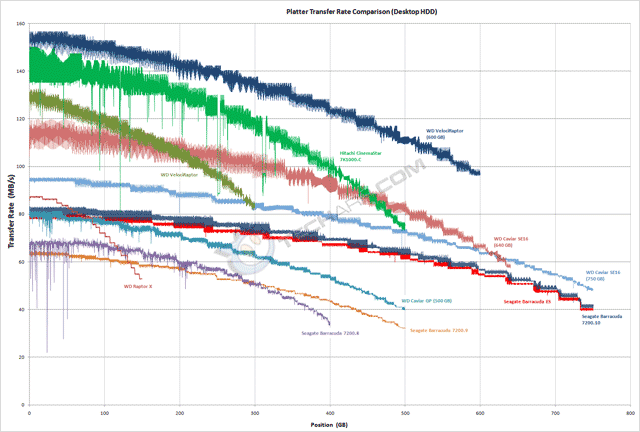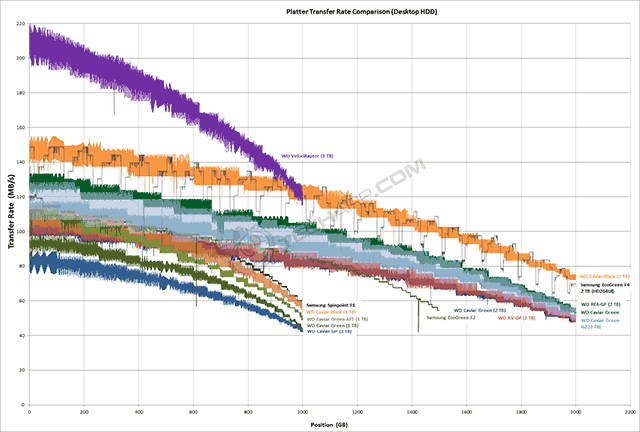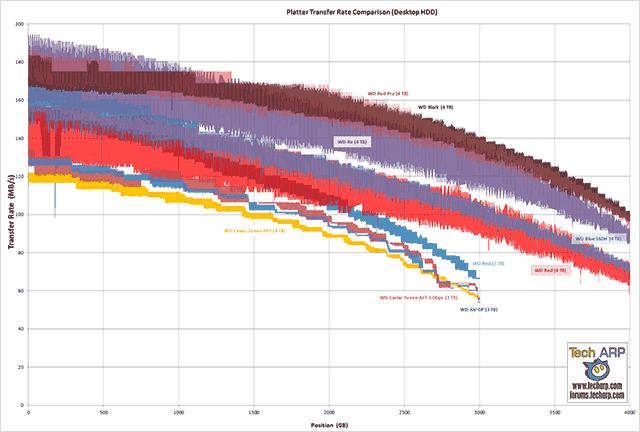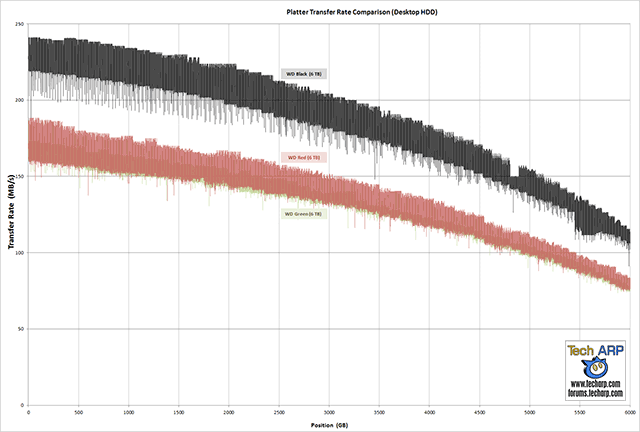Platter Transfer Rate Profile (Desktop HDDs)
This shows the actual transfer rate profile of each hard disk drive. Any large dip in transfer rate reflects the use of spare sectors to replace bad ones on the platters. Lots of dips in any curve is evidence of poor platter quality. However, keep in mind that platter quality varies from drive to drive and generally improves over time as the manufacturer improves the fabrication process.
The platter transfer rate profile is important as it gives you a better idea of how hard disk drives perform across the entire range of their storage capacity. Benchmark scores alone cannot tell you how a hard disk drive will perform across the entire platter.
The 1 TB Western Digital VelociRaptor had the highest transfer rate, up to 850 GB. Thereafter, its transfer rate was matched and then bested by the 2 TB Western Digital Caviar Black. The Caviar Black hard disk drive was better able to sustain its transfer rate because of its much higher storage capacity.
In hard disk drives that had the same areal density but different capacities, their platter profiles were quite different. A good example would be the 1 TB and 500 GB versions of the Western Digital Caviar GP hard disk drives. Both started out at roughly the same maximum transfer rate but because of its larger capacity, the 1 TB Caviar GP was able to better sustain its transfer rates than the 500 GB Caviar GP.
| If you like this article, please share it! -> |
Platter Transfer Rate Profile (Mobile HDDs)
This shows the actual transfer rate profile of each hard disk drive (or solid state drive). Any large dip in transfer rate reflects the use of spare sectors to replace bad ones on the platters. Lots of dips in any curve is evidence of poor platter quality. However, keep in mind that platter quality varies from drive to drive and generally improves over time as the manufacturer improves the fabrication process.
 |
Thanks to new high-density platters and a 7200 RPM spindle speed, the phenomenally fast 750 GB Western Digital Scorpio Black (WD7500BPKT) trashed the competition, at least for the first 600 GB. Thereafter, the 1 TB Western Digital Scorpio Blue (WD10JPVT) was faster (up till the 900 GB mark).
Newer 5400 RPM hard disk drives with even higher density platters like the 500 GB Scorpio Blue Slim (WD5000LPVT) actually beat 7200 RPM hard disk drives like the 500 GB Scorpio Black (WD5000BEKT) in transfer rate. This is why a faster spindle speed does not necessarily translate into higher transfer rates. That said, a higher spindle speed does have its advantages.
We can see the effect of the 7200 RPM spindle speed on performance by comparing the 500 GB Scorpio Black (WD5000BEKT) against its 5400 RPM brother, the 500 GB Western Digital Scorpio (WD5000BEVT). Both the Scorpio Black and the Scorpio use the same platters and thus have the same areal density. Because its larger 32 MB buffer has no effect on this test, the Scorpio Black's only advantage in this test is its higher spindle speed of 7200 RPM. This single change alone gave it a solid 10-11% boost in platter-to-buffer transfer rate.
Again, the capacity of a drive can affect its performance. Take for example, the Seagate Momentus 5400.5 and the Western Digital Scorpio. The Momentus 5400.5 started off much faster but because of its smaller 250 GB capacity, it could not sustain its transfer rate as well as the Scorpio. From the cross-over point of about 175 GB up till 300 GB, the Scorpio was actually faster than the Momentus 5400.5.
| If you like this article, please share it! -> |
Support Tech ARP!
If you like our work, you can help support out work by visiting our sponsors, participate in the Tech ARP Forums, or even donate to our fund. Any help you can render is greatly appreciated!
Details & Settings |
• Introduction |
|
| Real World Simulations | ||
|
||
Synthetic Tests |
||
|
||
|
||
|
||
Conclusion |
<<< Maximum Surface Temperature, Disk Transfer Rate : Previous Page | Next Page : 4 KB Access Performance >>>
Support us by buying from Amazon.com! |
|
| Grab a FREE 30-day trial of Amazon Prime for free shipping, instant access to 40,000 movies and TV episodes and the Kindle Owners' Lending Library! | |







 Add to Reddit
Add to Reddit




